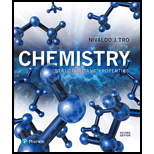
Consider the reaction:
The rate law for this reaction is:
Suppose that a 1.0 L reaction vessel initially contains 1.0 mol of
Want to see the full answer?
Check out a sample textbook solution
Chapter 14 Solutions
Mastering Chemistry with Pearson eText -- Standalone Access Card -- for Chemistry: Structure and Properties (2nd Edition)
- Curved arrows are used to illustrate the flow of electrons. Using the provided starting and product structures, draw the curved electron-pushing arrows for the following reaction or mechanistic step(s). Be sure to account for all bond-breaking and bond-making steps. NaO :0: Select to Add Arrows THF > Pleaarrow_forwardapp aktv.com Curved arrows are used to illustrate the flow of electrons. Using the provided starting and product structures, draw the curved electron-pushing arrows for the following reaction or mechanistic step(s). Be sure to account for all bond-breaking and bond-making steps. :0: 0:0 H NaO Select to Add Arrows CH3CH2CCNa Problem 31 of 35 Please select aarrow_forwardK Sepp aktiv com Curved arrows are used to illustrate the flow of electrons. Using the provided starting and product structures, draw the curved electron-pushing arrows for the following reaction or mechanistic step(s). Be sure to account for all bond-breaking and bond-making steps. Drawing Arrows CH3CH2OK, CH3CH2OH Altis Learning App 31 Problem 28 of 35 H. :0: H H H H H 0:0 H KO Undo Reset Donearrow_forward
- Q1: Draw the most stable and the least stable Newman projections about the C2-C3 bond for each of the following isomers (A-C). Are the barriers to rotation identical for enantiomers A and B? How about the diastereomers (A versus C or B versus C)? enantiomers H_ Br (S) CH 3 H3C (S) H Br A H Br 省 H3C (S) (R) CH₂ Br H C H Br H3C (R) B (R)CH3 H Br H Br H3C (R) (S) CH3 Br H D identicalarrow_forward4. Which one of the following is trans-1-tert-butyl-3-methylcyclohexane in its most stable conformation? (NOTE: Correct answer must be trans- and must have a 1,3-arrangement of groups.) C(CH3)3 CH₁₂ A H,C D H₂C C(CH) C(CH3)3 C B CH C(CH) C(CH3)3 Earrow_forwardPredict the Product. Predict the major organic product for the following reaction:arrow_forward
- Nonearrow_forward3. Which one of the following is the lowest energy, most stable conformation of 1-bromopropane? H H H H H H H H CH3 HH Br H CH3 b b b b b CH3 A Br Br H H B CH3 Br H C H H H D CH3 H Br H E Harrow_forwardIn evolution, migration refers to the movement of alleles between populations. In your drawings, compare and contrast migration in evolutionary terms vs. in ecological terms. True Falsearrow_forward
- Curved arrows are used to illustrate the flow of electrons. Using the provided starting and product structures, draw the curved electron-pushing arrows for the following reaction or mechanistic step(s). Be sure to account for all bond-breaking and bond-making steps. Problem 31 I 1 :0: O: C 1 1 H Na Select to Add Arrows CH3CH2CCNa 1arrow_forwardgiven asp ...arrow_forwardNonearrow_forward
 Chemistry & Chemical ReactivityChemistryISBN:9781337399074Author:John C. Kotz, Paul M. Treichel, John Townsend, David TreichelPublisher:Cengage Learning
Chemistry & Chemical ReactivityChemistryISBN:9781337399074Author:John C. Kotz, Paul M. Treichel, John Townsend, David TreichelPublisher:Cengage Learning Chemistry & Chemical ReactivityChemistryISBN:9781133949640Author:John C. Kotz, Paul M. Treichel, John Townsend, David TreichelPublisher:Cengage Learning
Chemistry & Chemical ReactivityChemistryISBN:9781133949640Author:John C. Kotz, Paul M. Treichel, John Townsend, David TreichelPublisher:Cengage Learning Chemistry: The Molecular ScienceChemistryISBN:9781285199047Author:John W. Moore, Conrad L. StanitskiPublisher:Cengage Learning
Chemistry: The Molecular ScienceChemistryISBN:9781285199047Author:John W. Moore, Conrad L. StanitskiPublisher:Cengage Learning General Chemistry - Standalone book (MindTap Cour...ChemistryISBN:9781305580343Author:Steven D. Gammon, Ebbing, Darrell Ebbing, Steven D., Darrell; Gammon, Darrell Ebbing; Steven D. Gammon, Darrell D.; Gammon, Ebbing; Steven D. Gammon; DarrellPublisher:Cengage Learning
General Chemistry - Standalone book (MindTap Cour...ChemistryISBN:9781305580343Author:Steven D. Gammon, Ebbing, Darrell Ebbing, Steven D., Darrell; Gammon, Darrell Ebbing; Steven D. Gammon, Darrell D.; Gammon, Ebbing; Steven D. Gammon; DarrellPublisher:Cengage Learning ChemistryChemistryISBN:9781305957404Author:Steven S. Zumdahl, Susan A. Zumdahl, Donald J. DeCostePublisher:Cengage Learning
ChemistryChemistryISBN:9781305957404Author:Steven S. Zumdahl, Susan A. Zumdahl, Donald J. DeCostePublisher:Cengage Learning





